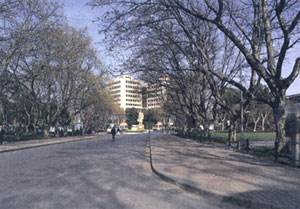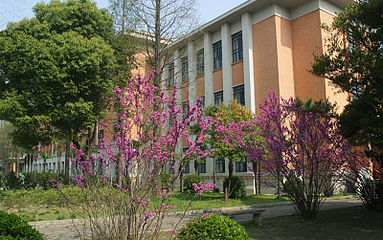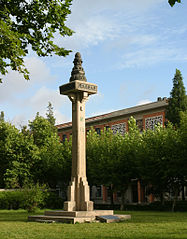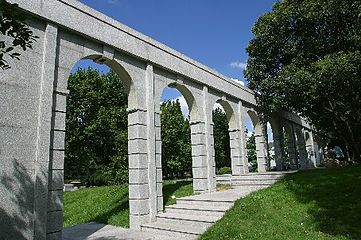Chung-Ang University
From Wikipedia, the free encyclopedia
Chung-Ang University (also known as
CAU; lit.
Central University) is a private university based in
Seoul.
Starting as a church-run kindergarten in 1918,
[1] CAU transformed into a female school for kindergarten teachers in 1922
[2] and was granted
university status in 1953.
[3]
The university claimed 2018 to be their centennial. It has 33,600
undergraduates, 5,200 graduates, 700 professors and 500 more part-time
teaching staff.
[4]
CAU is the first in South Korea to offer courses in Pharmacy,
Business Management, Mass Communication, Advertising & Public
Relations, Creative Writing, Photography, and Drama & Film Studies,
and is active in Pharmacy, Media and the Arts.
History
College of Pharmacy and R&D Center
Establishment 1918-1932
Chung-Ang University began with the establishment of Chung-Ang
Kindergarten as an annex to the Chung-Ang Methodist Church located in
Insa-dong, Jongno-gu, Seoul, in April 1918.
Chung-Ang Kindergarten originated as a branch of Jungdong Church in 1916 and separated in 1918.
In 1922, the Japanese enacted legislations against kindergartens to
restrict expansion, however, other kindergartens including Susong,
Kyungsung and Taewha, and kindergartens in Gaesung and Pyongyang were
founded by 1924.
Adversity 1933-1945
The social conventions in the 1920s made it difficult to recruit
female students but a Teacher Training Program was established and
kindergarten teachers were educated, which can be seen as a development
in the modern history of teaching in Korea. Undeterred by the hostile
conditions, graduates were posted to kindergartens in cities including
Hamhung, Hweryung, Busan, Masan, Jeonju, Anak, Cheonan, Sariwon, and
Milyang. Thus, the Chung-Ang Kindergarten Teacher Training Program took
on the role of a Professional Educational Institution.
By 1922, the Chung-Ang Teacher Training Program, in partnership with
the Community Education Movement of various Japanese-Resistance
organizations, was promoted to a Kindergarten Teacher Training School.
Although its legal status was registered as a Miscellaneous School, its
standing in social perception was considered equivalent to that of a
Professional School with a 3-year degree course.
The reformed Chung-Ang Teacher Training School continued to face
obstacles in management. With ten students, the school was forced to
relocate to a private residence in 1932 due to financial and personal
circumstances of the management, as the Japanese and accomplices
continually plotted to divide the community.
In 1933, Dr. Young-Shin Yim took over the helm and was appointed as
the principal at the age of 34. She was a graduate of Kijeon School for
Women, and was previously imprisoned for 6 months for leading the Samil
Independence Movement at Jeonju. She later graduated from Kwangdoo High
School in Japan and was further awarded her M.A in the United States.
She infamously sent pictures of the Japanese massacring Koreans during
the Gwandong earthquake to Dr. Syngman Rhee, who was operating the
Korean Independence Movement in the US.
After nine years in U.S., she returned to Korea in January 1932 and
was determined to devote herself to the nation, which was still under
Japanese rule. As she toured the country for her first role as the
Director of the YWCA, she realized that she needed to start with
education to save the people.
Her savings of 30,000 dollars earned from farming, truck driving, and
vegetable wholesale operation in U.S. was used to purchase a site at
Heukseok-dong on which to build a school and took leadership of
Chung-Ang Teacher Training School. Through Dr. Young-Shin Yim, Chung-Ang
began to envisage its development as the cradle of national education.
Despite its relocation to Heukseok-dong, Chung-Ang Teacher Training
School lacked facilities. So Dr. Young-Shin Yim rented Pearson Bible
School to hold classes. However, there was a limit to Dr. Young-Shin
Yim’s personal finances and with the Japanese prohibiting contributions,
the development of the School continued to face financial difficulties.
Believing that the only solution was to raise funds from U.S., Dr.
Young-Shin Yim worked to promote donations in the U.S. As a result, she
was able to return home having established the Pfeiffer Foundation in
U.S. to financially support Chung-Ang Teacher Training School.
With this, the first stone building was erected on the grounds of
Heukseok-dong in April 1937, to become Young-Shin Hall upon its
completion in May 1938, which forms the heart of Chung-Ang today.
Students subsequently founded Chosun Kindergarten Education Society,
and took charge of the social education plan through concerts, plays and
literary activities.
In 1937, the Japanese waged war against China, and in 1941 attacked
Pearl Harbor,
signalling the start of the Pacific War. Chung-Ang Teacher Training
School was heavily targeted in view of the fact that Dr. Young-Shin Yim
was educated in U.S. and a devout Christian.
The Communications Unit of the Japanese Army attempted to take siege
of the school, but their efforts were blocked by the strong resistance
of Dr. Young-Shin Yim. By the end of WW2, under pressure from the
Japanese forces, the school was no longer able to admit new students,
and the school was closed in 1944.
[citation needed]
Construction and development of a comprehensive university 1946-1955
As Japan was defeated and Korea liberated, Dr. Yim reopened the doors
to Chung-Ang Teacher Training School on 28 September 1945, and
established the school motto, “Live in Truth, Live for Justice”.
On 1 October of the same year, Chung-Ang Teacher Training School was
re-organised under the name of Chung-Ang Professional School for Women
and followed by the Admissions Ceremony. The Foundation, Chung-Ang
Culture Institute, was established in November 1946, and its legal
registration was completed by the following year.
In April 1947, the school was again reorganised into Chung-Ang
College for Women, and then to Chung-Ang College in May 1948,
establishing itself as a co-educational institution.
Whilst Dr. Yim served as a national diplomat in the United Nations,
obtaining their endorsement to build a new Korea, she also continued her
efforts in developing the school and was appointed Dean and Chairman of
the Board.
Although the college celebrated its first conferment of a Bachelor’s
Degree in May 1950, it was again indefinitely closed due to the outbreak
of the June 25 Korean War. Students were re-admitted subsequent to the
September 28 reclaim of the Country, but soon the school had to flee to
Busan and set up a temporary office there in the event of January 4
Retreat of Korea's allied forces.
Upon Dr. Yim’s return to the country in April 1951 after completing
her diplomatic duties in U.S., the school started to give lectures in
Song-do, Busan. Later, it installed branch campuses and lectures in Iri
and Seoul.
Chung-Ang College continued to provide education during the war
times. As a result the second, third and fourth Bachelor Degree
Conferment were held during the war years in Busan, in 1951, 1952 and
1953.
The school continued to provide education during the evacuation to
Busan and was recognised as a comprehensive university in February 1953.
Thus, with nine departments under four component faculties including
the College of Liberal Arts & Science, College of Law, College of
Business, and College of Pharmacy, and a Graduate School, Dr. Yim was
appointed as Chancellor of the University.
The teaching faculty returned from Busan to its original site in
Heukseok-dong, Seoul in August, following the declaration of ceasefire
in the Korean War in July of the same year. However, lectures had to be
taught in temporary buildings as the site was still occupied by the U.S.
Army. The site was eventually recovered after one semester in April
1954, and the area reorganised for the development of the university.
The university continued to expand to the scale of 19 departments
under four faculties, and a population of 2,850, between 1955 and 1959.
To accommodate the increase in departments and students, a
four-storey building, Pfeiffer Hall, was constructed across
approximately 2,500 pyeong in 1956, and Chung-Ang Library constructed
across approximately 3,800 pyeong in 1959.
Concurrently, International Culture Research Institute was established to enhance research activities.
Partnerships were forged with Young-Shin Junior High School,
Young-Shin Girls’ Junior High School, Nakyang Junior High School,
Nakyang Technical High School.
Preparation for takeoff 1956-1979
1960 saw the 4.19 Revolution, where the CAU students educated under
the motto of “Truth and Justice” protested against the 3.15 Rigged
Elections. Furthermore, despite the many challenges faced with the
control policy affecting student-intake for the alleged qualitative
improvement of universities, which was introduced in the wake of the
5.16 Military Coup in 1961, CAU was able to appoint Dr. Sung-Hee Yim as
its second chancellor on 2 October 1961. Later Dr. Young-Shin Yim was
re-appointed as the third chancellor, she was able to continue ensuring
the internal stability of the university.
In January 1965, the College of Liberal Arts & Science was
segregated into the College of Liberal Arts, College of Science &
Engineering and College of Education, whilst the College of Law, College
of Business, and College of Pharmacy were combined to form six
colleges. Furthermore, the partnered Middle School and High School were
renamed in affiliation with the College of Education, and an affiliate
Elementary School was newly established under the Foundation, allowing
the delivery of a coherent educational philosophy from kindergarten to
graduate school.
In February 1967, the Graduate School of Social Development was
established to train specialists and promote industrial links. In 1968,
the university was again reorganised into the eight component faculties,
including College of Liberal Art, College of Science & Engineering,
College of Education, College of Law, College of Political Science
& Economics, College of Business Administration, College of
Agriculture, and College of Pharmacy, for the systemization of education
impacting the affiliate organisations. The College of Medicine was
installed in December 1971, and Sung Shim Hospital, based in Jung-gu,
Seoul, was incorporated as an affiliate hospital.
July 1961 saw the construction of Jin Sun Hall across approximately
1,400 pyeong, and the University Theatre across 1,920 pyeong. In October
of the same year, the Social Development Hall was constructed across
1,600 pyeong. The Archives were reorganised to mark the 50th anniversary
in 1968. The Blue Dragon Monument was erected to safe-guard artefacts
and documents for the next 100 years, and Seungdang Hall built. Bobst
Hall, covering 3,200 pyeong, was built the following year, December
1969. The Sung Shim Hospital of 1,395 pyeong was affiliated.
By this time, the founder of CAU, Dr. Young-Shin Yim was over 70
years old and finding the workload physically gruelling. Thus, she
charged Dr. Chull Soon Yim to succeed her as the fourth chancellor of
CAU.
Dormitory in Anseong campus
The College of Liberal Arts and College of Science & Engineering
were restructured into the College of Liberal Arts & Science and
College of Engineering in 1972. In the field of art, CAU merged with
Seorabol Art College, which was operated by the Seorabol Art Institute,
in June 1972, and further reorganised the establishment under the
College of Arts in 1974. Two affiliate schools were constructed in 1978,
and the Graduate School of International Management and Graduate School
of Education installed in January 1979.
Jin Sun Hall was extended in October 1972 for construction of 3,100
pyeong of Seorabol Hall, and 2,400 pyeong devoted to the construction of
Natural Hall as part of the College of Medicine in 1974. The Students’
Union Building was constructed in December 1976 over 2,000 pyeong, and
in June 1978, a new annex provided over 1,450 pyeong for the affiliate
Sung Shim Hospital, based in Pil-dong, Jung-gu, Seoul.
In February 1977 Dr. Young-Shin Yim, the founder of CAU, died.
In March 1980, lecture halls, dormitories and a Students’ Union were
built across 2,417 pyeong, 1,706 pyeong, and 597 pyeong of land
respectively in Anseong-si, Gyeonggi-do, to create the Anseong Campus.
Adversity after expansion 1980-1986
Following the end of his term as chancellor, Dr. Chull Soon Yim was
succeeded by the professor of Philosophy, Dr. Suk-Hee Lee, as the fifth
chancellor in May 1980.
The Graduate School of Journalism was established in November 1980 to
train professional journalists, and Heukseok-dong equipped with
education facilities accordingly. In December, a 0.9-acre annex was
built for the affiliate hospital to improve the education environment
for the College of Medicine.
Improvements to facilities happened at the Seoul and the Anseong campuses.
In October 1981, faculties in Anseong were reorganised under the
College of Foreign Languages, College of Social Science, and College of
Home Economics. Seoul and Anseong sites were listed as the university’s
primary and secondary campus, respectively. The Department of Music was
segregated from the College of Arts and newly established as the College
of Music in October 1981. The College of Agriculture was reorganised as
the College of Industrial Science. The Graduate School of Construction
Engineering was added to the roster of faculties in September 1983.
After the establishment of the College of Construction Engineering in
the secondary campus in Anseong in October 1984, the secondary campus
had seven colleges.
Blue Dragon Pond on the Anseong campus
In November 1982, the Professor Research Center was built over 636
pyeong, and 626 pyeong was spared for the College of Agriculture
experiment area. In December, the building for the College of Arts was
built over 4,874 pyeong. Continuing the investments, 1,192 pyeong for
the Music College lecture area, 714 pyeong for the assembly area, and
423 pyeong for the swimming pool was established in August 1983. In
September, the Gymnasium was finished over 655 pyeong. In December 1984,
the 1,145 pyeong building was erected for the College of Music;
finally, 5,068 pyeong was given for the third faculty residence. By the
end, the campus had a modern look.
Dr. Byoung Jip Moon succeeded to Dr. Suk Hee Lee as the 6th president
in March 1985. Moon began to reorganize the management operating
system. The Office of Career Planning was established. The management of
the Chung-Ang Cultural Institute and the Medical Center were modified.
The departments of French Language & Literature and Japanese
Language & Literature were reinstalled, and the Department of
Industrial Information created. The construction of a Central Library in
the second campus was promoted.
Realization of vision 2008
Dr. Bum Hoon Park was inaugurated as the 12th University President in
February 2005. As his first assignment upon election, he oversaw the
evaluation of the Korean Council for University Education, marketing of
capital, BK21, establishment of the Professional Graduate School of Law,
and other national enterprises.
Restructuring of the Education Science Technology Faculty, which had
been the greatest pending issue, was so successful it was nominated a
leading university and awarded grant maintenance (KRW 9,100,000,000)
comparable to that of major competitor universities, in spite of its
1-year probationary period.
Following the restructuring of the undergraduate programmes,
recruiting of new admissions, registration of current students,
financial situation and overall management records of the three
professional schools and 11 specialised schools, were analysed to
identify the areas for improvement and enhance teaching quality. Thus,
32 out of 42 staff from the professional schools and specialized schools
were reassigned to the general graduate school, and 10 positions
reduced. The members reassigned to the general graduate school have been
resourced to serve as the primary models in forming the Research
Priority Group (Staff), for the construction of a research-centric
regime.
DRAGON 2018(2001–2004), which was the development plan devised under
the 11th university president to carry the university towards the
university target vision by the Centenary Anniversary, was re-branded as
CAU2018+(2005–2008). CAU2018+ lists the valuation index for various
industries and the source of expected revenue in detail. To accomplish
the goals, CAU2018+ was implemented in two stages.
For the first four years of Dr. Bum Hoon Park’s term in office,
resources were heavily invested in education/research equipment. Thus,
the nation’s largest Law Hall was constructed in February 2007, and a
master plan drawn up for the construction of the Pharmacy and Natural
Science R&D Centers around the Main Entrance in Campus 1, and an
Engineering R&D Center by the Gymnasium,
In 2008, the Media Practice Section was established in the Law Hall
and 400 additional wards were added in the affiliate hospital.
Accordingly, the Chung-Ang Site Construction Plan, included in the
CAU2018+ Development Plan was set in motion.
In November 2007, authorisation was obtained from Hannam-si, for developing a tertiary, Hannam Campus.
Camp Colbern,
which was previously a US Army instillation of 86,000 pyeong will be
renovated for the purpose. A team will be banded per subject field to
oversee the management.
244 full-time teaching staff were recruited between 2005 and 2009,
and in the first semester of 2009, 25 full-time and part-time staff were
recruited.
Law and Medical Schools were established in March 2009.
Student dorm in Seoul campus (Blue Mir Hall)
KRW 40 billion of development funds, KRW 166.3 billion of external
research grant, and KRW 17.3 billion in government aid allocated as a
government-funded enterprise have been secured over the 4 years since
Dr. Bum Hoon Park’s inauguration into office. The sum of KRW 223.6
billion is the largest amount secured financially in the history of the
university.
In May 2008, a global corporation, Doosan Group, was incorporated as
an educational institution, and Yong-Sung Park was elected as the 9th
Chairman of the Board.
The appointment of Chairman Park, who negotiated the industry-shift
of Doosan Group from consumer goods to heavy industry, symbolises the
rebirth of the university. Within 80 days of taking office, a meeting
was held with the teaching staff on 27 August 2008, where the CAU2018+
Mid-Term Development Plans were announced along with the new strategy
direction of “Choice and Concentrate, Strengthening of Executive
Ability, Establishment of Virtuous Cycle Structure”.
The Degree Management System has been strengthened to encourage
students to study diligently, as in order to graduate, students have
been made to attain a minimum level in compulsory subjects such as
English and Accounting.
In order to the support this type of research, education and practice
more effectively, an R&D Center for the College of Pharmacy and new
Dormitories for students were constructed, the Central Library
renovated, and the hospital extended to fit 300 additional wards.
Research projects are also being supported by the Special Committee for Strengthening the Research Marketability.
Such changes have already resulted in the designation of six new
companies in the second stages of the BK21 enterprise, and a budget of
KRW 6 billion being allocated to the leading research team, thus
implementing the “choice and concentrate” strategy.
The direct election system for presidency was abolished, and replaced
by the appointment system. Consequently, the 12th President, Dr. Bum
Hee Park, was re-appointed into office as the consecutive 13th
president.
The largest project being persevered by Dr. Bum Hee Park and the
corporation, is the establishment of Hannam Campus. In 2007, a
Memorandum of Understanding was exchanged with Hannam, and thus
preparation for the creation of Hannam Campus are currently underway.
As of February 2009, Chung-Ang University, as a comprehensive
institution, has produced one general graduate school, five professional
graduate schools, 11 specialised graduate schools, 18 modularised
colleges in the campuses across Seoul and Anseong, and issued a total of
147,196 Bachelor Degrees, 29,940 Masters Degrees, and 4,275 Doctorates.













